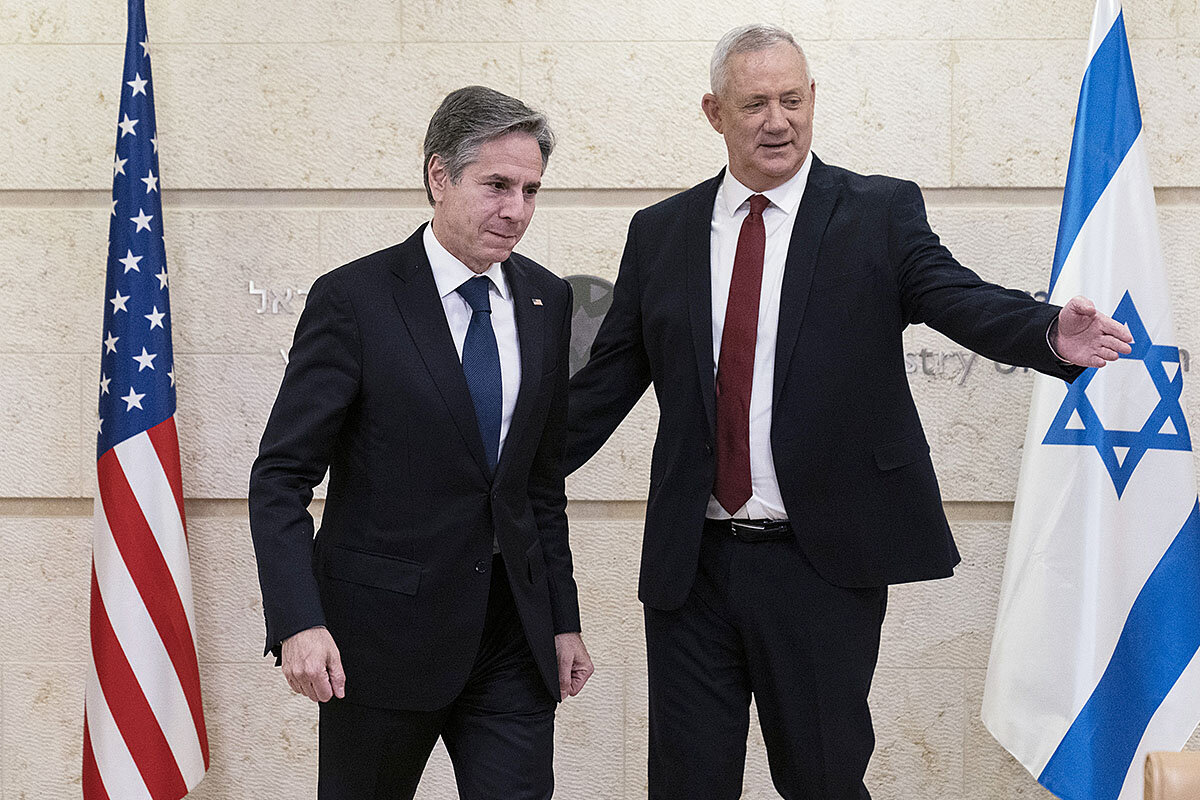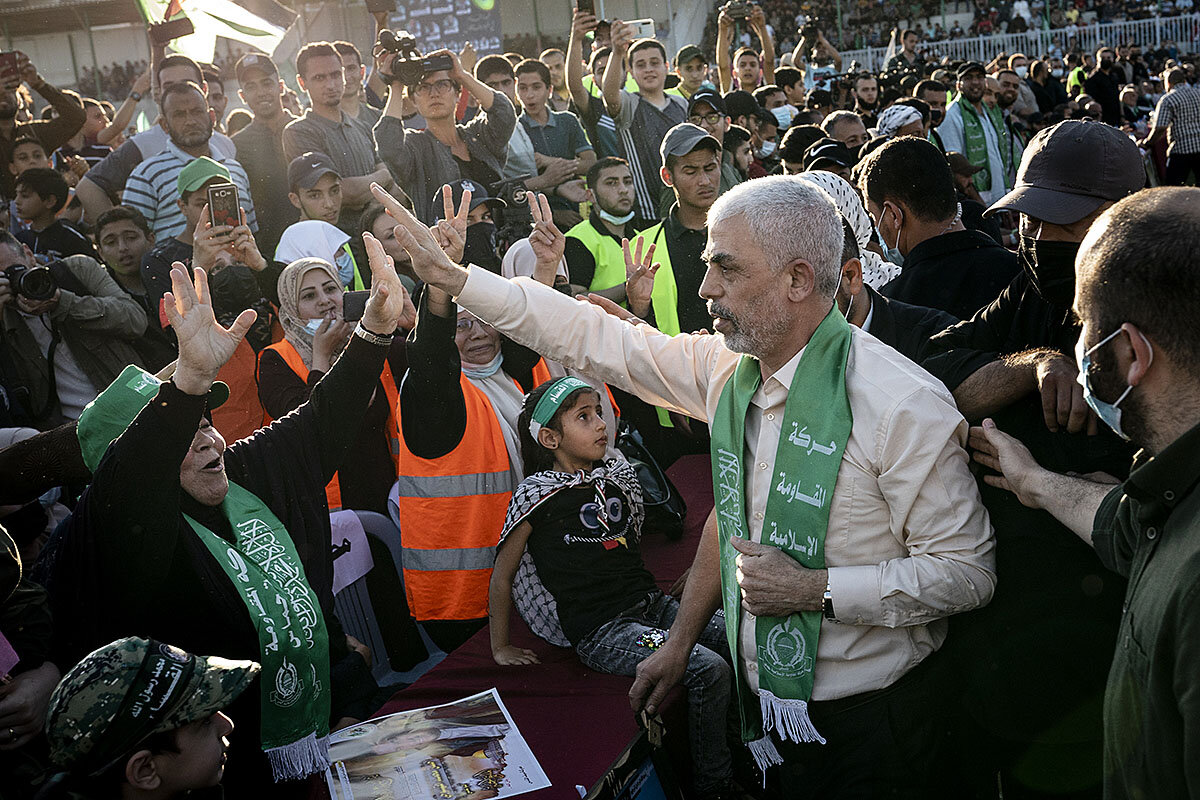Israel's goal: A rebuilt Gaza, without a rearmed Hamas
Loading...
| Tel Aviv, Israel
This week – after a truce between Israel and Hamas quietened the skies – columns of trucks have been rumbling into the Gaza Strip, stacked high with boxes of international aid for beleaguered residents.
They mark the first step in a new effort by Israel and the international community to pull off a precarious balancing act, one that has eluded them in the past.
The challenge? To improve the lives of the 2 million people in Gaza, where many are mired in poverty, while ensuring that the Islamist militant group Hamas, which rules the enclave, does not spend the aid money on rebuilding its rocket arsenal.
Why We Wrote This
Can Israel and Hamas break out of the cycle of recurrent violence that has afflicted them? Some in Israel say that the path to peace will only be paved with Gaza’s prosperity.
As Israel emerges from perhaps the most bruising of its four wars with Hamas, some Israeli government and defense officials are beginning to ask how they might end the cycle of violence for good, rather than simply postpone its next eruption.
Israel should not “turn a military victory into a diplomatic missed opportunity,” insisted Benny Gantz, Israel’s defense minister, in his first public comments since a cease-fire ended 11 days of indiscriminate rocket fire from Gaza onto Israeli cities and punishing retaliatory bombing raids.
Mr. Gantz offered no details of any diplomatic or strategic moves Israel might make to bring long-term peace to the Gaza Strip, but his reasoning is clear: If Gazans’ everyday lives were made more livable, they would have a greater stake in stability and put more pressure on Hamas not to ratchet up tensions with Israel.
Former U.S. Mideast envoy Dennis Ross agrees. Hamas rulers “coerce their public, but they are not indifferent to their public,” he told The Times of Israel on Wednesday.
Start from the bottom
With peace between Israelis and Palestinians still a distant dream, diplomats are keeping their eyes on the ground. “We know that to prevent a return to violence, we have to use the space created [by the cease-fire] to address a larger set of underlying issues and challenges,” said U.S. Secretary of State Antony Blinken after meeting Israeli and Palestinian leaders this week.
“That begins with tackling the grave humanitarian situation in Gaza and starting to rebuild,” he added.
Mr. Blinken announced the White House would ask Congress for $75 million in economic development aid for the Palestinians. To address immediate needs in Gaza, he said the United States would provide $5.5 million and give another $32 million to the United Nations Relief and Works Agency, UNRWA.
That money is badly needed. One of the most densely populated places in the world, the Gaza Strip suffers from rudimentary and unreliable electricity, water and sewage services, 60% youth unemployment, and a deep sense of frustration.
The mood is intensified by Israel’s grip on Gaza. Although Israel dismantled Jewish settlements there and withdrew its soldiers in 2005, it controls six of the seven border crossing points (the other leads to Egypt), Gaza’s airspace, and its coastline. It strictly limits who and what goes into and out of the enclave, giving Israel tight control of key economic levers.
In recent years it has relaxed its blockade on Gaza somewhat, allowing 10,000 residents to work in Israel, for example, and permitting the import of some goods that cannot be used or adapted for military purposes, identified as “dual use.”
But the Israeli government could be much more generous, says Sari Bashi, an Israeli expert in international humanitarian law. She says the blockade is an example of collective punishment, not justified by security considerations, and now would be a good time to lift it completely.
“The restrictions on goods leaving Gaza for sale in Israel and the West Bank are political, not security related, and lifting them would provide an economic boost,” she argues. “Same for restrictions on many kinds of inputs called dual use goods; and allowing laborers and merchants to travel into and out of Gaza.”
How to do it
But there will be conditions on international aid aimed at reviving the Gazan economy. “Asking the international community … to rebuild Gaza only makes sense if there is confidence that what is rebuilt is not lost again because Hamas decides to launch more rocket attacks in the future,” Mr. Blinken cautioned.
Some observers, though, do not think any amount of aid will help. “We have a crazy fantasy that a new economy will make Hamas less hostile,” laments Dan Schueftan, a security analyst who once advised the late Israeli Prime Ministers Ariel Sharon and Yitzhak Rabin. “But over the years they have received billions of dollars [in foreign aid] and it’s failed.”
A number of mechanisms are being floated to ensure Hamas does not, for example, divert cement shipments intended for the reconstruction of homes or sewage pipes to the repair of the underground tunnels where it stores rockets and hides its fighters.
They include bringing in United Nations or Egyptian inspectors; boosting the role of the more moderate Palestinian Authority, Hamas’ rival which rules the West Bank; inviting foreign companies to do some of the rebuilding; stepping up intelligence sharing between Israel and Egypt on what’s happening on the ground; and installing tracking devices on delivery trucks and remote cameras in warehouses to monitor incoming goods.
“I don’t think anyone has fleshed this out,” says Neri Zilber, a journalist and adjunct fellow of The Washington Institute. “That’s why it’s so difficult. You can put a thousand ideas down on a piece of paper in a conference room, but that does not change the fact that Hamas will still be controlling things on the ground.”
“We need to be more sophisticated, not just think about this for the Palestinians, but for the future of the state of Israel,” argues Ronni Shaked, a columnist at Yediot Ahronot, a leading Israeli newspaper, who would like Israel to formulate a clear vision of aid to Gaza. “I’m worried we are just at the beginning of a countdown to the next war.”









